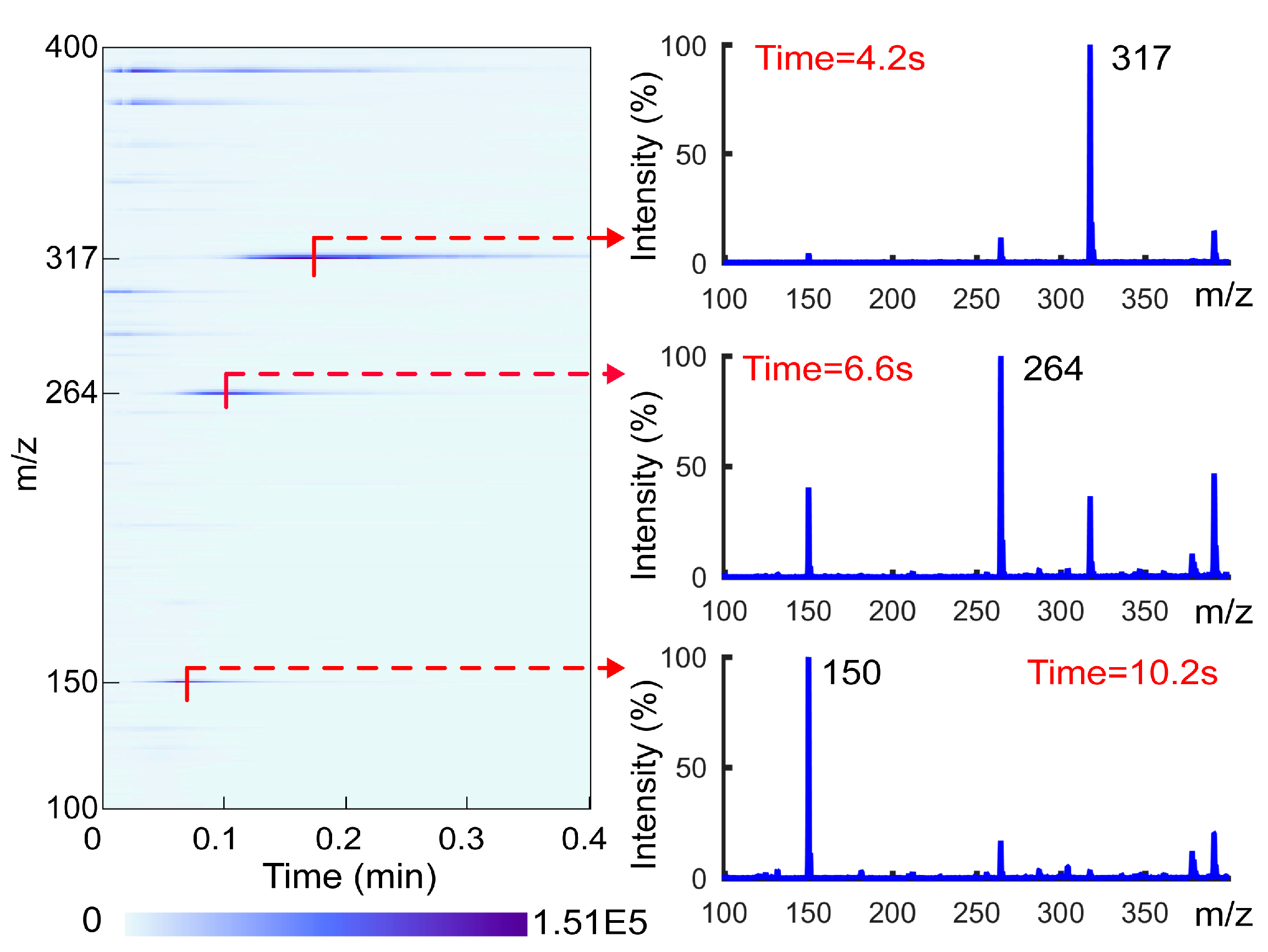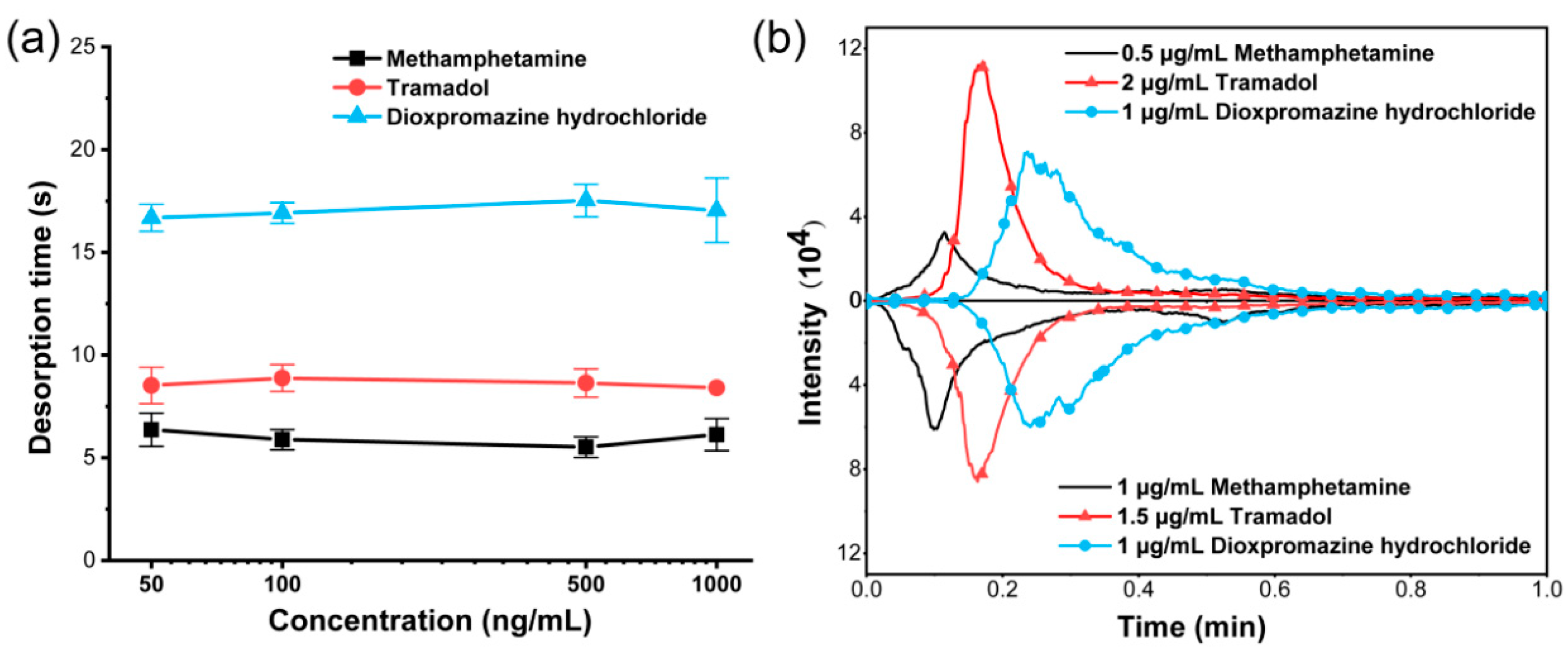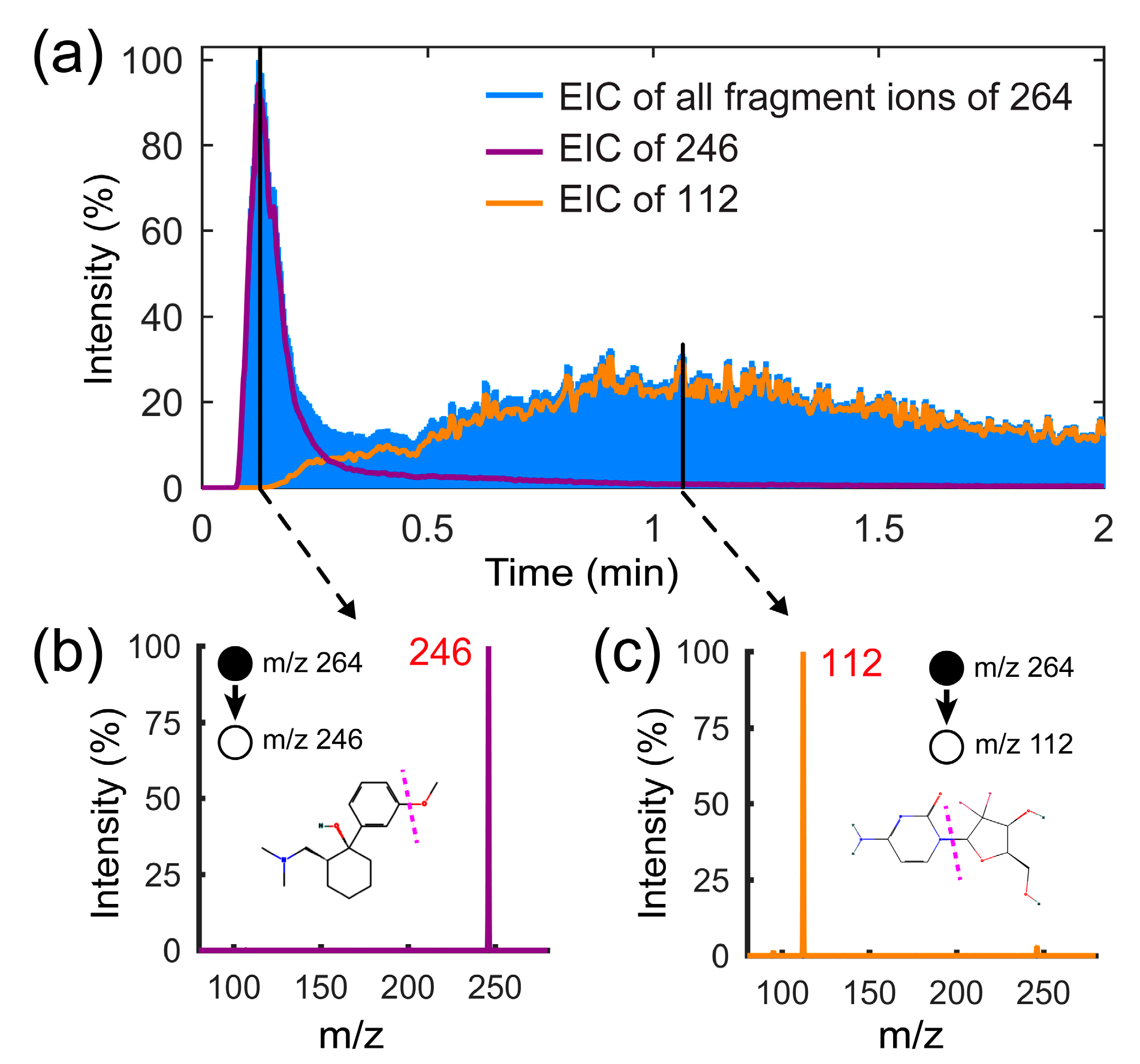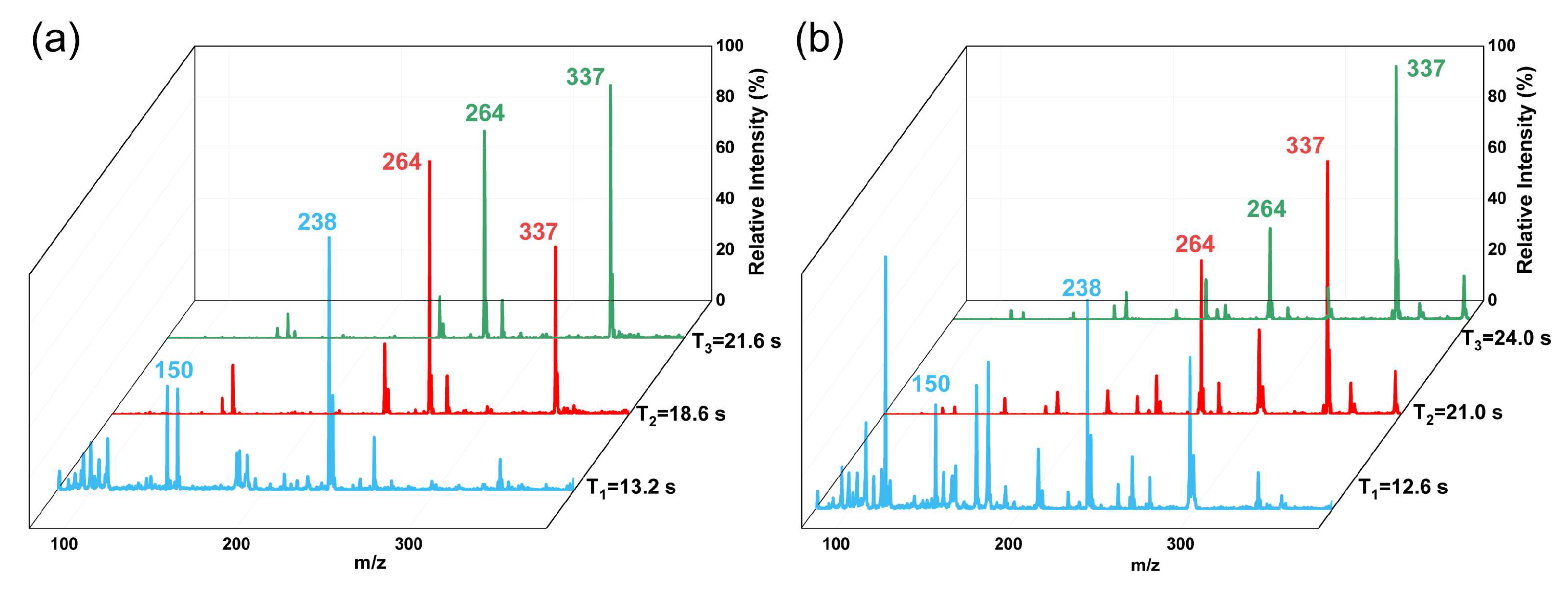Rapid Separation and Detection of Drugs in Complex Biological Matrix Using TD-CDI Mass Spectrometer
Abstract
:1. Introduction
2. Materials and Methods
2.1. Chemicals and Materials
2.2. Instrumentation
3. Results and Discussion
3.1. Basic Separation Effect Verification
3.2. Performance Optimization
3.3. Analyses of Drugs with Similar m/z
3.4. Detection of Actual Samples
4. Conclusions
Author Contributions
Funding
Institutional Review Board Statement
Informed Consent Statement
Data Availability Statement
Conflicts of Interest
References
- Zeng, X.; Xu, L.; Xiao, X. Negative implicit in-group stereotypes of Chinese male drug abusers: Evidence from ERP. Curr. Psychol. 2023, 42, 23861–23873. [Google Scholar] [CrossRef] [PubMed]
- Guerri, C.; Pascual, M. Impact of neuroimmune activation induced by alcohol or drug abuse on adolescent brain development. Int. J. Dev. Neurosci. 2019, 77, 89–98. [Google Scholar] [CrossRef] [PubMed]
- Solis, E., Jr.; Cameron-Burr, K.T.; Kiyatkin, E.A. Heroin Contaminated with Fentanyl Dramatically Enhances Brain Hypoxia and Induces Brain Hypothermia. eNeuro 2017, 4, e0323-17. [Google Scholar] [CrossRef] [PubMed]
- Hazin, R.; Cadet, J.L.; Kahook, M.Y.; Saed, D. Ocular manifestations of crystal methamphetamine use. Neurotox. Res. 2009, 15, 187–191. [Google Scholar] [CrossRef] [PubMed]
- Quinton, M.S.; Yamamoto, B.K. Causes and consequences of methamphetamine and MDMA toxicity. AAPS J. 2006, 8, E337–E347. [Google Scholar] [CrossRef] [PubMed]
- Kertesz, S.G.; Gordon, A.J. A crisis of opioids and the limits of prescription control: United States. Addiction 2019, 114, 169–180. [Google Scholar] [CrossRef] [PubMed]
- O’Donnell, J.; Tanz, L.J.; Gladden, R.M.; Davis, N.L.; Bitting, J. Trends in and characteristics of drug overdose deaths involving illicitly manufactured fentanyls—United States, 2019–2020. Morb. Mortal. Wkly. Rep. 2021, 70, 1740. [Google Scholar] [CrossRef] [PubMed]
- Valdez, C.A. Gas Chromatography-Mass Spectrometry Analysis of Synthetic Opioids Belonging to the Fentanyl Class: A Review. Crit. Rev. Anal. Chem. 2022, 52, 1938–1968. [Google Scholar] [CrossRef] [PubMed]
- Nisbet, L.A.; Wylie, F.M.; Logan, B.K.; Scott, K.S. Gas Chromatography-Mass Spectrometry Method for the Quantitative Identification of 23 New Psychoactive Substances in Blood and Urine. J. Anal. Toxicol. 2019, 43, 346–352. [Google Scholar] [CrossRef]
- Hassan, S.S.M.; Kamel, A.H.; Awwad, N.S.; Aboterika, A.H.A. Characterization of Some “Hashish” Samples in the Egyptian Illicit Trafficking Market Using a Thermal Separation Probe and Gas Chromatography–Mass Spectrometry. ACS Omega 2023, 8, 25378–25384. [Google Scholar] [CrossRef]
- Zhang, W.; Wang, X.; Xia, Y.; Ouyang, Z. Ambient Ionization and Miniature Mass Spectrometry Systems for Disease Diagnosis and Therapeutic Monitoring. Theranostics 2017, 7, 2968–2981. [Google Scholar] [CrossRef] [PubMed]
- Feider, C.L.; Krieger, A.; DeHoog, R.J.; Eberlin, L.S. Ambient Ionization Mass Spectrometry: Recent Developments and Applications. Anal. Chem. 2019, 91, 4266–4290. [Google Scholar] [CrossRef]
- Kuo, T.-H.; Dutkiewicz, E.P.; Pei, J.; Hsu, C.-C. Ambient Ionization Mass Spectrometry Today and Tomorrow: Embracing Challenges and Opportunities. Anal. Chem. 2020, 92, 2353–2363. [Google Scholar] [CrossRef]
- Rankin-Turner, S.; Heaney, L.M. Applications of ambient ionization mass spectrometry in 2020: An annual review. Anal. Sci. Adv. 2021, 2, 193–212. [Google Scholar] [CrossRef] [PubMed]
- Yan, M.; Zhang, N.; Li, X.; Xu, J.; Lei, H.; Ma, Q. Integrating Post-Ionization Separation via Differential Mobility Spectrometry into Direct Analysis in Real Time Mass Spectrometry for Toy Safety Screening. Anal. Chem. 2024, 96, 265–271. [Google Scholar] [CrossRef]
- Vircks, K.E.; Mulligan, C.C. Rapid screening of synthetic cathinones as trace residues and in authentic seizures using a portable mass spectrometer equipped with desorption electrospray ionization. Rapid Commun. Mass Spectrom. 2012, 26, 2665–2672. [Google Scholar] [CrossRef]
- Brown, H.; Oktem, B.; Windom, A.; Doroshenko, V.; Evans-Nguyen, K. Direct Analysis in Real Time (DART) and a portable mass spectrometer for rapid identification of common and designer drugs on-site. Forensic Chem. 2016, 1, 66–73. [Google Scholar] [CrossRef]
- Espy, R.D.; Teunissen, S.F.; Manicke, N.E.; Ren, Y.; Ouyang, Z.; van Asten, A.; Cooks, R.G. Paper spray and extraction spray mass spectrometry for the direct and simultaneous quantification of eight drugs of abuse in whole blood. Anal. Chem. 2014, 86, 7712–7718. [Google Scholar] [CrossRef]
- Wiley, J.S.; Shelley, J.T.; Cooks, R.G. Handheld low-temperature plasma probe for portable “point-and-shoot” ambient ionization mass spectrometry. Anal. Chem. 2013, 85, 6545–6552. [Google Scholar] [CrossRef]
- Santos, H.I.; Pinheiro, K.M.P.; Richter, E.M.; Coltro, W.K.T. Determination of scopolamine and butylscopolamine in beverages, urine and Buscopan® tablets samples using electrophoresis microchip with integrated contactless conductivity detection. Talanta 2024, 266, 124960. [Google Scholar] [CrossRef]
- Liu, M.; Yang, H.; Hu, J.; Shen, B.; Xiang, P.; Qiang, H.; Deng, H.; Yu, Z.; Shi, Y. Analysis of 28 hair samples from users of the hallucinogenic beverage ayahuasca. Forensic Sci. Int. 2021, 323, 110790. [Google Scholar] [CrossRef] [PubMed]
- Halim, S.A.; Low, J.H.; Chee, Y.C.; Alias, M.R. Seizures among young adults consuming kratom beverages in Malaysia: A case series. Epilepsy Behav. 2021, 121, 108057. [Google Scholar] [CrossRef]
- Zhao, C.; Dong, Y.; Feng, Y.; Li, Y.; Dong, Y. Thermal desorption for remediation of contaminated soil: A review. Chemosphere 2019, 221, 841–855. [Google Scholar] [CrossRef]
- Prestage, J.; Day, C.; Husheer, S.L.G.; Winter, W.T.; Ho, W.O.; Saffell, J.R.; Hutter, T. Selective Detection of Volatile Organics in a Mixture Using a Photoionization Detector and Thermal Desorption from a Nanoporous Preconcentrator. ACS Sens. 2022, 7, 304–311. [Google Scholar] [CrossRef] [PubMed]
- Reiss, R.; Ehlert, S.; Heide, J.; Pütz, M.; Forster, T.; Zimmermann, R. Ambient Pressure Laser Desorption—Chemical Ionization Mass Spectrometry for Fast and Reliable Detection of Explosives, Drugs, and Their Precursors. Appl. Sci. 2018, 8, 933. [Google Scholar] [CrossRef]
- Cheng, S.-C.; Tsai, Y.-D.; Lee, C.-W.; Chen, B.-H.; Shiea, J. Direct and rapid characterization of illicit drugs in adulterated samples using thermal desorption electrospray ionization mass spectrometry. J. Food Drug Anal. 2019, 27, 451–459. [Google Scholar] [CrossRef]
- Cheng, S.C.; Lee, R.H.; Jeng, J.Y.; Lee, C.W.; Shiea, J. Fast screening of trace multiresidue pesticides on fruit and vegetable surfaces using ambient ionization tandem mass spectrometry. Anal. Chim. Acta 2020, 1102, 63–71. [Google Scholar] [CrossRef]
- Wang, W.; Wang, S.; Xu, C.; Li, H.; Xing, Y.; Hou, K.; Li, H. Rapid Screening of Trace Volatile and Nonvolatile Illegal Drugs by Miniature Ion Trap Mass Spectrometry: Synchronized Flash-Thermal-Desorption Purging and Ion Injection. Anal. Chem. 2019, 91, 10212–10220. [Google Scholar] [CrossRef] [PubMed]
- Wang, S.; Wang, W.; Li, H.; Xing, Y.; Hou, K.; Li, H. Rapid On-Site Detection of Illegal Drugs in Complex Matrix by Thermal Desorption Acetone-Assisted Photoionization Miniature Ion Trap Mass Spectrometer. Anal. Chem. 2019, 91, 3845–3851. [Google Scholar] [CrossRef]
- Guo, X.; Zhai, J.; Ma, L.; Wu, Q.; Bai, H.; Ma, Q. Rapid on-site screening of five prohibited ingredients in cosmetics using thermal desorption-corona discharge ionization coupled with ion mobility spectrometry. Se Pu 2019, 37, 233–238. [Google Scholar] [CrossRef]
- Terence, G.H.; Inese, S.; Karen, R.B.; Yunxia, W.; David, M.; Ronald, E.S. Identifying and Overcoming Matrix Effects in Drug Discovery and Development. In Tandem Mass Spectrometry; Jeevan, K.P., Ed.; IntechOpen: Rijeka, Croatia, 2012; p. Ch. 19. [Google Scholar] [CrossRef]
- Ke-Guo, T.; Jing, G.; Li-li, Y.; Quan, Y.; Xiao-Hao, W. Development and Application of Self-aspiration Hollow Needle Corona Discharge Ionization Source. Chin. J. Anal. Chem. 2022, 50, 1143–1149. [Google Scholar]
- Yang, Q.; Chen, S.; Li, Y.; Jiao, T.; Cheng, L.; Yu, Q.; Lu, X. Mass spectrometry analysis of drugs using an integrated thermal desorption corona discharge ionization device. Int. J. Mass Spectrom. 2023, 494, 117149. [Google Scholar] [CrossRef]








Disclaimer/Publisher’s Note: The statements, opinions and data contained in all publications are solely those of the individual author(s) and contributor(s) and not of MDPI and/or the editor(s). MDPI and/or the editor(s) disclaim responsibility for any injury to people or property resulting from any ideas, methods, instructions or products referred to in the content. |
© 2024 by the authors. Licensee MDPI, Basel, Switzerland. This article is an open access article distributed under the terms and conditions of the Creative Commons Attribution (CC BY) license (https://creativecommons.org/licenses/by/4.0/).
Share and Cite
Shi, W.; Ye, Z.; Yang, Q.; Zhou, J.; Wang, J.; Huo, X. Rapid Separation and Detection of Drugs in Complex Biological Matrix Using TD-CDI Mass Spectrometer. Biosensors 2024, 14, 271. https://doi.org/10.3390/bios14060271
Shi W, Ye Z, Yang Q, Zhou J, Wang J, Huo X. Rapid Separation and Detection of Drugs in Complex Biological Matrix Using TD-CDI Mass Spectrometer. Biosensors. 2024; 14(6):271. https://doi.org/10.3390/bios14060271
Chicago/Turabian StyleShi, Wenyan, Zi Ye, Qin Yang, Jianhua Zhou, Jiasi Wang, and Xinming Huo. 2024. "Rapid Separation and Detection of Drugs in Complex Biological Matrix Using TD-CDI Mass Spectrometer" Biosensors 14, no. 6: 271. https://doi.org/10.3390/bios14060271




